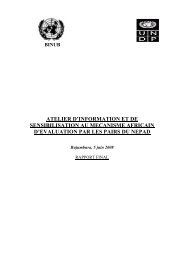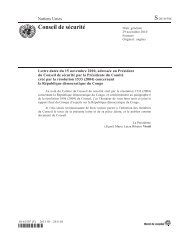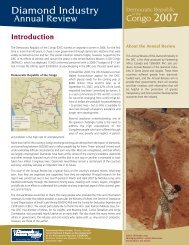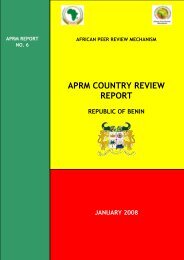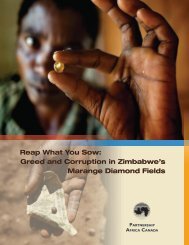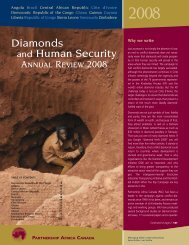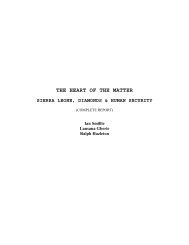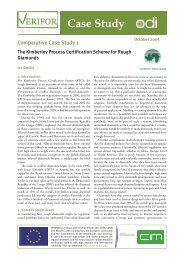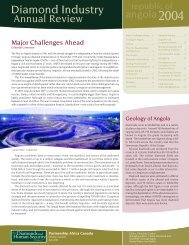Angola 2007 - Diamond Development Initiative
Angola 2007 - Diamond Development Initiative
Angola 2007 - Diamond Development Initiative
- No tags were found...
You also want an ePaper? Increase the reach of your titles
YUMPU automatically turns print PDFs into web optimized ePapers that Google loves.
Private Sector PlayersSetting up a Joint VentureIn the formal sector, diamonds are exploited exclusively by means of an<strong>Angola</strong>n-registered joint venture partnership between Endiama, acting astrustee for the nation’s mineral rights, and a foreign company with the requisiteinvestment funds and technical expertise. In addition, one or moresmaller <strong>Angola</strong>n companies are normally included as minor partners.The process for creating a joint venture is now fairly standardized, if notespecially speedy. The foreign company presents Endiama with a letter ofintent. Endiama then evaluates the prospective company both for technicalcapacity and financial depth. If both are in order, negotiations turn toselecting a specific 3000 km 2 diamond concession.In recent years, Endiama has been encouraging foreign companies toshift their attention from the Lundas to areas along the Malange-Bié axis,as well as further south in Moxico Province. Of course, the foreigninvestor may already have an idea of where it wants to operate. A limitedamount of back and forth may thus ensue until a concession is agreedupon. Although not part of the formal process, in practice the investormay also request some modifications to the concession boundaries.The selection of a concession triggers the entry of an <strong>Angola</strong>n private sectorpartner. According to Endiama, there is an <strong>Angola</strong>n companyattached to every available concession. Though the legal basis of this linkageis somewhat dubious, it is apparently indissoluble.The actual percentage allotted to each participant is negotiable, withincertain boundaries. With alluvial projects, Endiama and the <strong>Angola</strong>n partnermust jointly own at least 50% of the partnership. Typically, Endiamatakes somewhere between 35 and 45%, the foreign investor takes thesame, leaving 15-25% for the <strong>Angola</strong>n partner. Some of the more powerfulforeign investors, including SPE of Portugal, De Beers and Brazil’sOdebrecht have managed to eliminate the <strong>Angola</strong>n partner entirely, splittingthe projects 50-50 with Endiama. More typical is the split reached onthe Chitotolo project, in which Endiama took 45%, ITM of Bermuda took40% and Lumanhe took 15%.For Kimberlite mines, Endiama must by law own at least 51% of the project.An exception was made for the Catoca mine, where Endiama traded18% of the project for a much needed cash infusion from a Lev Levievcompany, reducing its share to only 32.8%. On the Luô project, Endiamatook its full 51%, while foreign investors Escom-Alrosa (a partnership ofPortugal’s Esprito Santo bank and the Russian diamond giant Alrosa) took45%, leaving 2% each for two well-connected <strong>Angola</strong>n firms,Hipergesta and Angodiam.Endiama has a fairly standard joint venture contract, but in recent yearsforeign investors have been demanding the right to maintain managementcontrol of their project, no matter the division of shares in the partnership.The contract for the Cambuia Project between Endiama,Equatorial <strong>Diamond</strong>s (registered in the British Virgin Islands) and a troikaof <strong>Angola</strong>n firms – Miningest, Sambukila and N’Jula Investments – is fairlytypical in this regard. 8 While broad direction of the company is ostensiblyin the hands of a three-man council in which each of the parties hasa representative, the contract also stipulates that the general director andchief financial officer be indicated by the foreign partner, Equatorial. 9All investment, and all risk, is explicitly the responsibility of the foreigninvestor. For alluvial projects the minimum investment is US$5 million,while for kimberlitic projects, the minimum is US$10 million, and theaverage much more.As a final step, the project must then be approved by the <strong>Angola</strong>n government,either by the Ministry of Geology and Mines for alluvial projects,or the Council of Ministers (the <strong>Angola</strong>n cabinet) for Kimberlite projects.A new joint venture becomes official upon its publication in the governmentgazette, the Diário da República, and only then can field work canbegin. Average time from letter of intent to publication in the Diario isabout two years.The joint venture system might seem dauntingly disadvantageous for theforeign investor, who has to provide all the money and technical expertisein return for something less than a half share in the final enterprise.However, there seems no lack of mining companies eager to do businessin <strong>Angola</strong>, including most of the majors. Russian giant Alrosa, BHP Billitonand De Beers all have one or more concessions in the exploration stage.According to Endiama’s director of planning and investment, there are atotal of 156 concessions delineated in <strong>Angola</strong>, of which 12 are in full production,30 are in the early start-up phase of production, 15 are in theprospecting and exploration phase, and about 100 are greenfield siteswaiting for an investor to fund exploration.The Role of Local PartnersThe murky and politicized manner in which private <strong>Angola</strong>n companiesgain access to the country’s diamond resources is an ongoing area of concernwith respect to <strong>Angola</strong>’s diamond industry. As described above (see3.1 Setting up a Joint Venture) somewhere between 15-25% of everyalluvial project, and just under 5% of kimberlite projects are allocated byEndiama to private <strong>Angola</strong>n companies.<strong>Angola</strong>’s <strong>Diamond</strong> Law states that ‘participation by national firms shouldbe encouraged, as long as they meet the necessary technical and financialconditions.’ 10 According to industry insiders, however, the <strong>Angola</strong>ncompanies bring neither investment capital nor technical expertise to thetable.These companies are all connected in one way or another to government,’said one diamond mining executive who has negotiated severaljoint ventures with Endiama. The only thing they offer are political ties toimportant players in the <strong>Angola</strong>n government or army, and with themthe ability to influence government decision making.6



